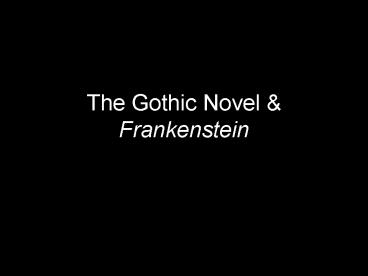The Gothic Novel PowerPoint PPT Presentation
1 / 14
Title: The Gothic Novel
1
The Gothic Novel Frankenstein
2
The Gothic Novel
- Frankenstein is by no means the first Gothic
novel. Instead, this novel is a compilation of
Romantic and Gothic elements combined into a
singular work with an unforgettable story. - The Gothic novel is unique because by the time
Shelley wrote Frankenstein, several novels had
appeared using Gothic themes, but the genre had
only been around since 1754.
3
The Gothic Novel
- The first Gothic horror novel was The Castle of
Otranto by Horace Walpole, published in 1754. - The Castle of Otranto - The basic plot created
many other gothic staples, including a
threatening mystery and an ancestral curse, as
well as countless trappings such as hidden
passages and oft-fainting heroines. - Perhaps the last type of novel in this mode was
Emily Brontes Wuthering Heights, published in
1847. In between 1754 and 1847, several other
novels appeared using the Gothic horror story as
a central story telling device, The Mysteries of
Udolpho (1794) and The Italian (1794) by Ann
Radcliffe, The Monk (1796) by Matthew G. Lewis,
and Melmouth the Wanderer (1820) by Charles
Maturin.
4
The Gothic Novel
- The Gothic novel set in some exotic place like
Italy and involving a heroine (or, less often,
hero) in a struggle with the mysteriously evil
and seemingly supernatural. - A landscape of vast dark forest with vegetation
that bordered on excessive, concealed ruins with
horrific rooms, monasteries and a forlorn
character who excels at the melancholy.
5
The Gothic Novel
- It is the predecessor to modern horror and, above
all, has led to the common definition of "gothic"
as being connected to the dark and horrific. - Prominent features of gothic novels included
terror, mystery, the supernatural, ghosts,
haunted buildings, castles, trapdoors, doom,
death, decay, madness, hereditary curses, and so
on.
6
Mary Shelley
- Mary Shelley was twenty when Frankenstein was
published, twenty-four when her husband drowned
although she wrote a good many other things, her
fame clearly rests on her archetypal tale of the
monster and his creator.
7
Archetype
- Archetype is defined as the original pattern from
which copies are made. The word Archetype is
derived from the Latin noun archetypum, meaning a
template, mold or copy.
8
Gothic Traits in Frankenstein
- Frankenstein is set in continental Europe,
specifically Switzerland and Germany, where many
of Shelleys readers had not been. Further, the
incorporation of the chase scenes through the
Arctic regions takes us even further from England
into regions unexplored by most readers. - Victors laboratory is the perfect place to
create a new type of human being. Laboratories
and scientific experiments were not known to the
average reader, thus this was an added element of
mystery and gloom.
9
Gothic Traits in Frankenstein
- The thought of raising the dead would have made
the average reader wince in disbelief and terror.
Imagining Victor wandering the streets of
Ingolstadt after dark on a search for body parts
adds to the sense of revulsion purposefully
designed to evoke from the reader a feeling of
dread for the characters involved in the story.
10
Gothic Traits in Frankenstein
- In the Gothic novel, the characters seem to
bridge the mortal world and the supernatural
world. - Frankensteins monster seems to have some sort of
communication between himself and his creator,
because the monster appears wherever Victor goes.
- The monster also moves with amazing superhuman
speed with Victor matching him in the chase
towards the North Pole.
11
Mary Shelley
- Shelley had incorporated a number of different
sources into her work, not the least of which was
the Promethean myth from Ovid. - The influence of John Miltons Paradise Lost, the
book the 'creature' finds in the cabin, is also
clearly evident within the novel.
12
The Modern Prometheus"
- The novel's subtitle
- Prometheus, in some versions of Greek mythology,
was the Titan who created mankind, and Victor's
work by creating man by new means obviously
reflects that creative work. More widely known
is that Prometheus was the bringer of fire who
took fire from the gods and gave it to man. Zeus
then punished Prometheus by fixing him to a rock
where each day a predatory bird came to devour
his liver. - Prometheus was also a myth told in Latin but was
a very different story. In this version
Prometheus makes man from clay and water, again a
very relevant theme to Frankenstein as Victor
rebels against the laws of nature and as a result
is punished by his creation.
13
The Modern Prometheus"
- Prometheus' relation to the novel can be
interpreted in a number of ways. - For Romance era artists in general, Prometheus'
gift to man compared with the two great utopian
promises of the 18th century the Industrial
Revolution and the French Revolution, containing
both great promise and potentially unknown
horrors. - Byron was particularly attached to the play
Prometheus Bound by Aeschylus, and Percy Shelley
would soon write Prometheus Unbound.
14
What else is going on in literature, besides
Romanticism and The Gothic Novel?
- Jane Austen, the first great nineteenth-century
novelist, was, in some sense the last great
eighteenth-century novelist ironic, comic,
promoting the values of reason and restraint. - 1818, a year after Austens death, saw the
(anonymous) publication of Frankenstein, quite a
different sort of novel.

